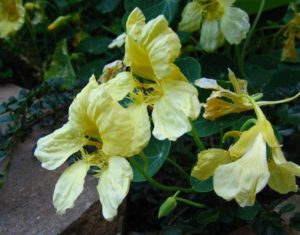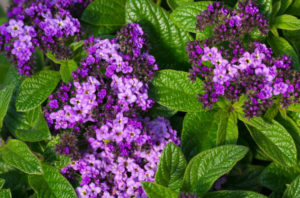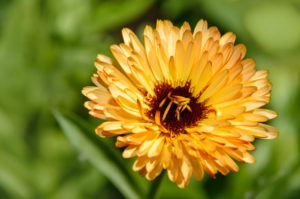
Nasturtium (Tropaeolum majus) is a perennial plant; in culture it is grown as an annual herbaceous plant with succulent stems, a densely branched shrub reaching 100-300 cm (3.3-9.8 ft); it can grow into a bush 30-60 cm (1-2 ft) high.
The leaves are bright green, large, 2.5-6 cm (1-2.4 in) long, thyroid-shaped, rounded-uneven, long-stemmed. Flowers 5-6 cm (2-2.4 in) in diameter, simple, semi-double or double, with original processes in the form of spurs; bright yellow, orange, red, cherry, pale cream, salmon (a variety of colors in color increase spots and strokes of different shades); bloom from June until the first autumn frosts. Fruits are united achenes; ripen in August-September. Nasturtium is native to South America.

Decorative varieties and hybrids:
- Hermine Grashoff – double flowers, bright red;
- Kaiserin von Indian – height 30-35 cm (1-1.1 ft), dark green leaves with a purple hue, dark orange-red flowers;
- Empress of India – dwarf — up to 30 cm (1 ft) -plants, leaves purplish-green, flowers semi-double, velvety, red;
- Peach Melba – dwarf, 23-30 cm (9-11.8 in), semi-double flowers, creamy yellow with an orange-red center;
- series Jewel – dwarf, up to 30 cm (1 ft), semi-double and double flowers, yellow, pink-orange, bright or dark red;
- Golden Gleam – curly variety, semi-double flowers, golden yellow;
- series Tom Thumb – dwarf – up to 24 cm (9.4 in) tall, flowers yellow, orange, red, light pink, orange-pink;
- series Whirlybird – dwarf, up to 24 cm (9.4 in), flowers are simple or semi-double, red, pink, yellow, orange;
- Scarlet Gleam -braided variety with bright red flowers.

Nasturtium is a cultivated spicy, medicinal, decorative, insecticidal (capable of destroying harmful insects) plant. Leaves, flowers with a sharp, spicy taste are eaten (this is a good vitamin supplement in salads, soups, vegetable and meat dishes; flavoring and coloring of cheese, butter), flower buds, green fruits (pickled as capers, a delicacy), fresh or pickled unripe seeds with a pleasant spicy taste (used in salads and first courses).
For medicinal purposes, herbs and seeds with anti-scurvy, diuretic, restorative effects are used; medicinal plants are useful for heart diseases, atherosclerosis, anemia, bronchitis, kidney diseases, metabolic disorders, skin diseases.
Nasturtium is especially decorative during flowering: bright flowers create a colorful range with a predominance of warm tones. Depending on the intensity of the growth of shoots, this flower can be used in various elements of the landscape design of the estate, giving it an incendiary South American flavor. So, climbing varieties are used in vertical gardening using supports, or as ampels for decorating containers, high beds, or as groundcover, forming a chic curtain on semi-shaded areas. Bush varieties are good in flower beds, mixborders, in a pond. Planted between tomatoes, cucumbers, potatoes, nasturtium will not only decorate the garden, but also protect it from pests and diseases.
The distance between plants during planting is 25-30 cm (9.8-11.8 in), climbing varieties are placed according to the scheme 70 x 30 cm (2.3×1 ft). They prefer moist, not too fertile soil.




Leave a Reply